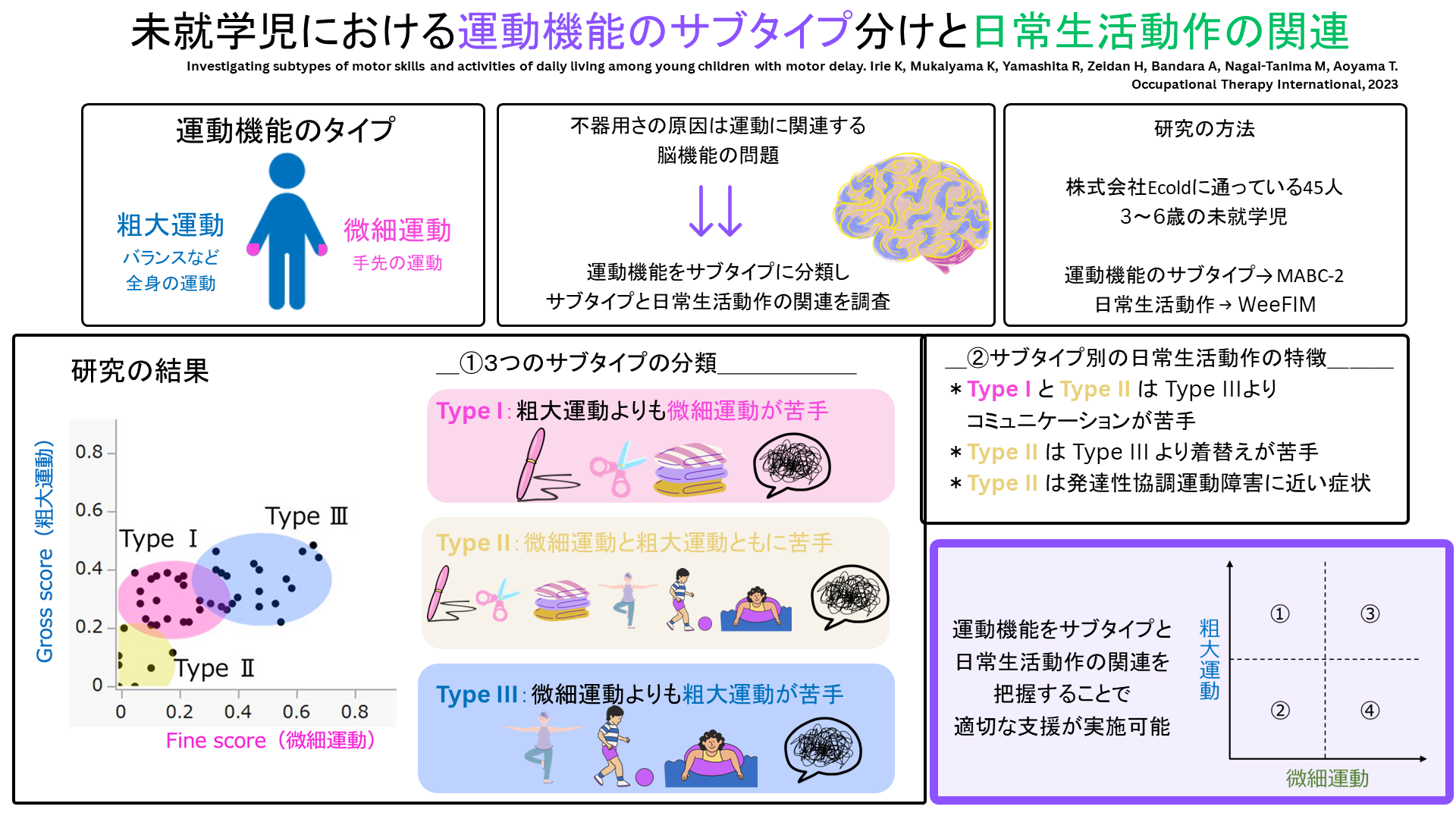未就学児における運動機能のサブタイプ分けと日常生活動作の関連
「不器用」という言葉は,療育の現場でよく用いられます.不器用さの原因は協調(運動)に関連する脳機能の問題であることが分かってきています.一連の脳機能のうち,全体または一部の問題により不器用さを呈していることが考えられます.これまで,不器用さの状態をいくつかのサブタイプ(種類)に分類した研究はありましたが,日常生活動作との関連に言及したものは限られていました.今回,京都大学大学院医学研究科人間健康科学系専攻先端リハビリテーション科学コースにおける先端作業療法学講座と先端理学療法学講座のチームと株式会社 Ecold の共同研究にて,未就学児の運動機能のサブタイプと日常生活動作の関連を調査しました.その結果,子どもたちは1)Type I は粗大運動よりも微細運動が苦手,2)Type II は微細運動と粗大運動ともに苦手,3)Type III は微細運動より粗大運動が苦手,という3つのサブタイプに分類されました.さらに,タイプ別の日常生活動作との関連では,Type II はコミュニケーションスキルと上半身と下半身の着替えが苦手という特徴が明らかになりました.このサブタイプは,その他にもいくつかの分類が想定され,日常生活動作に加えて遊びや睡眠との関係を詳しく調べていくことで,個別の症状に応じた適切な支援および療育のエビデンスの検証につながることが期待されます.本研究成果は、2023年6 月15 日に、国際学術誌「Occupational Therapy International」にオンライン掲載されました。
https://doi.org/10.1155/2023/4031372

“Clumsiness” is a word often used in the field of Habilitation. It is known by now that clumsiness is caused by problems in brain function that is related to motor coordination, and it could be related to one part or different parts of brain function. There have been studies dividing clumsiness into subtypes (classifications), however, clumsiness subtypes clarifying the relation with activities of daily living have been scars. This time, the joint research between the team of Advanced Occupational Therapy Course and Advanced Physical Therapy Course belonging to the Advanced Rehabilitation Science Course, Department of Human Health Sciences, Graduate School of Medicine, Kyoto University and Ecold Co. Ltd, have investigated the relation between motor function subtypes and activities of daily living of preschool children. As a result, three children’s subtypes were identified: 1) Type I children who are weaker at fine motor skills than motor skills, 2) Type II children who are weak at both fine motor skills and gross motor skills, and 3) Type III children who are weaker gross motor skills than fine motor skills. Furthermore, by comparing the activities of daily living of the three subtypes, they found that Type II children are characterized by weakness in communication skills and difficulties in dressing the upper and lower body. Several other classifications can be assumed for this subtype and investigating in detail its relation with play and sleep in addition to activities of daily living will provide evidence for appropriate support and treatment according to individual symptoms. This paper’s results have been published online in the international journal “Occupational Therapy International” on 06/15/2023

